If you’re launching or scaling a print-on-demand (POD) business, one of the most critical decisions you’ll make is selecting the custom blank tees for print-on-demand. While designs matter, the base fabric your art is printed on can make or break customer satisfaction, print durability, and your brand’s long-term success.
Table of Contents
This comprehensive guide walks you through everything you need to know about choosing high-quality custom-blank-tees for POD—whether you’re in U.S.A or selling globally.
1. What Makes a Good Blank Tee for POD?
Not all t-shirts are created equal. The quality of your blank tee directly affects how your design prints, how the shirt feels when worn, and how long it lasts. Here are the main factors to consider:
Material Quality
- 100% Combed Cotton: This is the most popular fabric for POD because it’s soft, breathable, and provides an excellent surface for direct-to-garment (DTG) and direct-to-film (DTF) printing.
- Cotton-Polyester Blends: Slightly more durable and wrinkle-resistant than pure cotton. Best suited for sublimation or screen printing.
- Organic Cotton: A sustainable, eco-friendly choice. These shirts feel premium but usually come at a higher price point.
Fabric Weight (GSM)
- 160–180 GSM: Lightweight to medium-weight fabrics. Ideal for standard everyday wear and layering.
- 180–240+ GSM: Heavier, more premium feel. These are preferred for oversized and streetwear fits.
Fit and Style
- Classic Fit (Unisex): Works well across demographics. Great for general use and gender-neutral designs.
- Oversized Fit: A popular trend in streetwear and Gen Z fashion. Offers relaxed, baggy appeal.
- Slim Fit: Preferred for athletic wear or tailored styles. Highlights body shape.
Color Range
- White and Neutrals: The most print-compatible. They allow designs to pop with full vibrancy.
- Dark Colors (Black, Navy): Require special underbase printing for DTG, but look premium when done correctly.
Print Compatibility
- DTG (Direct-to-Garment): Best for full-color, complex designs on cotton shirts.
- DTF (Direct-to-Film): Great for bold, vibrant prints and works on both cotton and blended fabrics.
- Screen Printing: Ideal for bulk orders with limited color palettes.
- Sublimation: Only compatible with polyester or high polyester-content blends.
3. Where to Source Blank Tees for POD
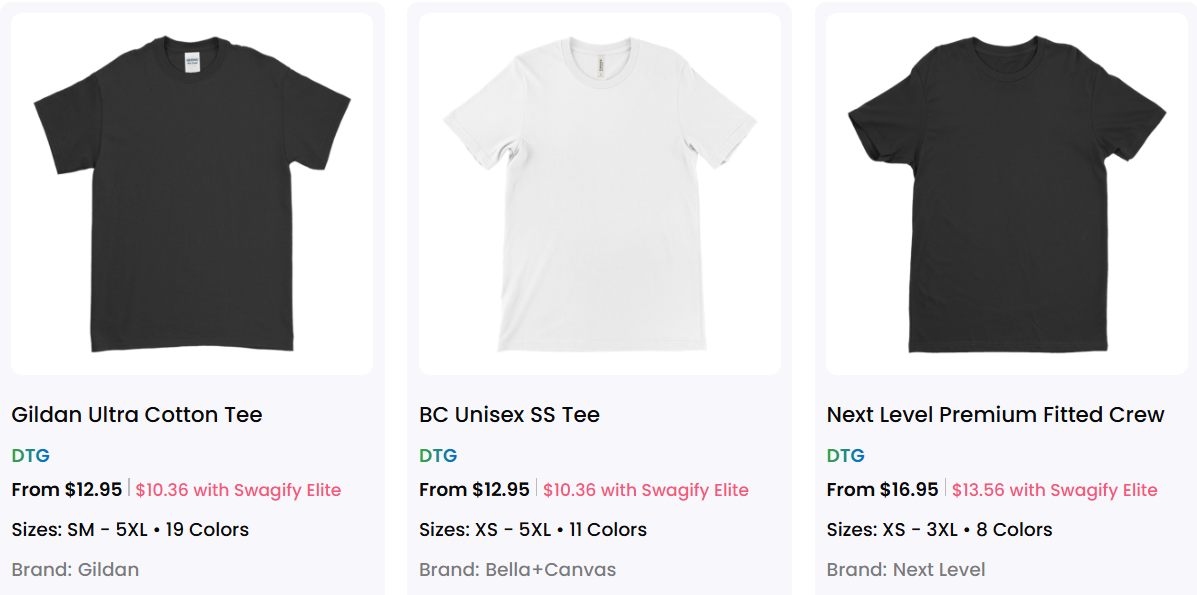
Finding the right blank tee supplier is critical to your print-on-demand success. The quality of your base garment affects everything—from customer satisfaction to print clarity and brand reputation. Below are top platforms to source POD-friendly blank tees in 2025, starting with Swagify.
1. SwagifyPOD
Why Choose SwagifyPOD:
Swagify is rapidly becoming the go-to POD platform for U.S. brands looking for quality, customization, and scalable solutions. With a growing catalog of premium blank tees, competitive pricing, and U.S.-based fulfillment, it’s perfect for startups and established sellers alike.
- Key Features:
- Premium blanks (heavyweight, oversized, and classic fits)
- Full DTG, DTF, and screen-printing support
- Custom branding: private labels, inside neck tags, and packaging
- Fast fulfillment from U.S. facilities
- Shopify and WooCommerce integration
- Ideal For: Streetwear brands, creators, or anyone seeking better quality control and branding customization than mainstream POD platforms.
2. Printful
Printful is known for its user-friendly interface, fast fulfillment, and extensive apparel catalog. Their blank tees include high-end names like Bella+Canvas, Gildan, and AS Colour.
- Strengths:
- No inventory or minimums required
- Easy integration with Shopify, Etsy, and Amazon
- Offers branding options like printed labels and pack-ins
- Best For: Entrepreneurs looking to launch with recognizable blanks and strong backend support.
3. Printify
Printify connects you to multiple POD suppliers, giving you flexible pricing and production options. Whether you’re on a budget or want premium quality, Printify makes it easy to choose.
- Strengths:
- Wide range of t-shirt types and fabrics
- Choose from domestic or international print providers
- Perfect for price-conscious sellers testing designs
- Best For: Sellers who want to compare costs and quality across several vendors before scaling.
4. Gelato
Gelato is a globally-minded platform that works well for U.S. brands with international customers. With a robust EU and U.K. supplier network, it’s a solid option for fast delivery across continents.
- Strengths:
- Quick shipping to over 30 countries
- Local production reduces carbon footprint
- Broad catalog with tees, hoodies, and more
- Best For: Brands looking to scale internationally with eco-conscious fulfillment.
Bonus: U.S. Bulk & Specialty Suppliers
If you prefer to buy in bulk and handle printing yourself or through a local provider, these options are worth considering:
- VS Tees: High-quality blank tees with consistent sizing and excellent dye absorption—ideal for brands that want a premium U.S.-based supplier.
- TSC Apparel: Offers bulk pricing on blanks from trusted brands like Comfort Colors, Gildan, and Next Level.
- Bella+Canvas Direct: Order blanks straight from the manufacturer for consistency and bulk discounts.
Pro Tip: Always test multiple blanks before committing. Order samples with your design printed on them so you can compare shrinkage, softness, print clarity, and fit.
Best Printing Methods for Custom Tees
| Printing Method | Pros | Cons | Best For |
|---|---|---|---|
| Screen Printing | Durable, vibrant colors, cost-effective for bulk orders | Setup cost is high, not ideal for small batches | Bulk orders, bold and simple designs |
| Direct-to-Garment (DTG) | Full-color designs, great for small orders, no setup cost | Slower process, best on 100% cotton, less durable than screen printing | Small batches, detailed and colorful designs |
| Heat Transfer Vinyl (HTV) | Crisp results, good for names/numbers, flexible application | Not ideal for complex designs, may crack or peel over time | Custom sports jerseys, small personalized designs |
| Sublimation | Vibrant, long-lasting, no texture feel | Works only on light-colored polyester | All-over prints, performance tees |
| Heat Transfer Printing | Easy to use, affordable equipment | Can fade or peel after washes | DIY, small batches, temporary or trendy designs |
| Embroidery | Premium feel, long-lasting | Expensive, limited color detail | Logos, uniforms, premium branded apparel |
Choosing the right printing method is essential to producing high-quality, long-lasting custom t-shirts. Each technique offers unique advantages depending on your design, fabric type, and order volume. Here’s a deeper look at the top printing methods used in 2025:
1. Direct-to-Garment (DTG)
- Best for: Complex, full-color designs, gradients, and photographic prints
- Fabric compatibility: Works best on 100% cotton tees
- Pros:
- No setup cost—great for one-offs and small batches
- High-resolution prints with rich color depth
- Cons:
- Not ideal for dark polyester fabrics without pretreatment
- Slower for large volume orders
2. Direct-to-Film (DTF)
- Best for: High-color, flexible designs across cotton, blends, and even polyester
- Fabric compatibility: Works well on both light and dark fabrics
- Pros:
- Vibrant color quality
- Soft, flexible finish that doesn’t crack easily
- Easy to apply on a variety of fabrics
- Cons:
- Slightly thicker feel than DTG
- May require adhesive powder and heat press setup
3. Screen Printing
- Best for: Bulk orders with limited colors (logos, slogans, simple art)
- Fabric compatibility: Cotton and blends
- Pros:
- Very cost-effective at high volumes
- Extremely durable and vibrant colors
- Cons:
- Not ideal for complex or photo-realistic prints
- Requires screens and setup, making it inefficient for small orders
4. Sublimation
- Best for: All-over prints and bright designs on polyester fabrics
- Fabric compatibility: Only works with polyester or high-polyester blends
- Pros:
- Seamless, permanent print that won’t fade or crack
- Great for activewear, performance tees
- Cons:
- Won’t work on cotton
- Limited to light-colored fabrics for best results
Which to Choose?
- DTG or DTF: Best for small-run brands selling high-detail art on Shopify or Etsy
- Screen printing: Best for wholesale and event merch
- Sublimation: Perfect for polyester-based activewear or creative all-over designs
Pro Tips for Choosing the Right Blank Tee
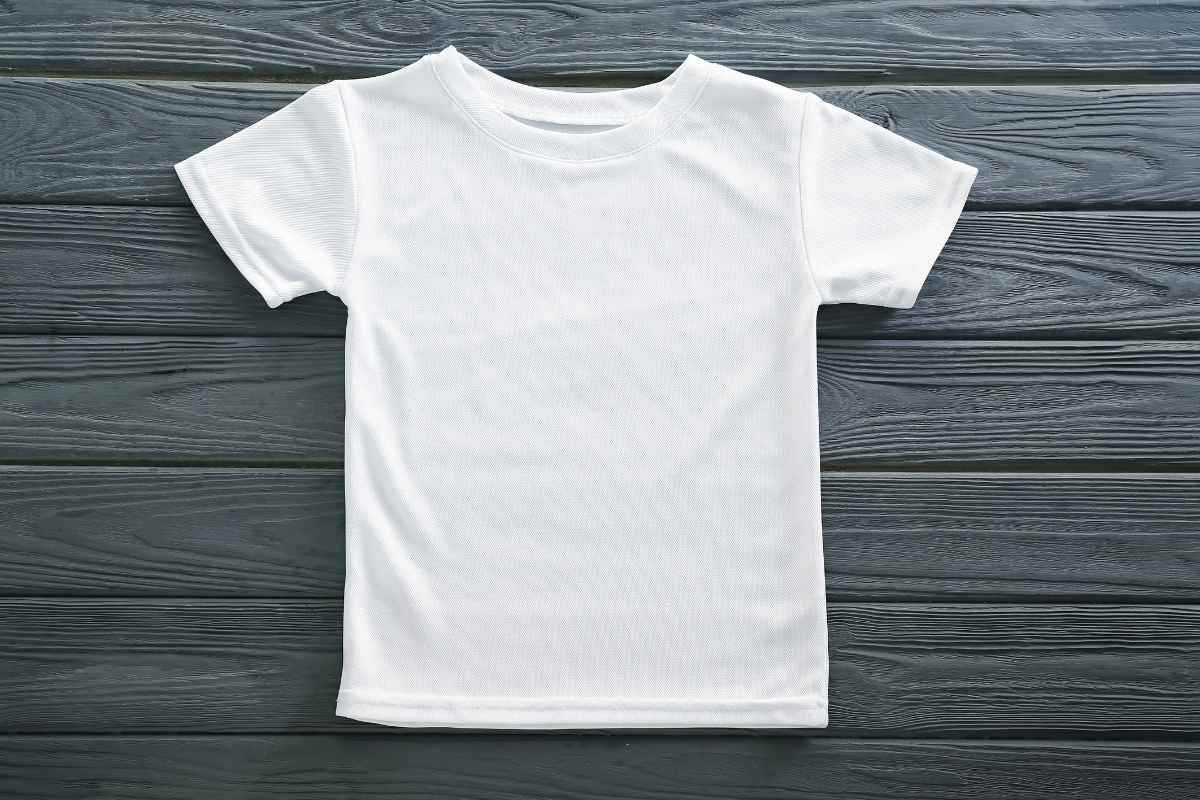
Your t-shirt’s quality determines how customers perceive your brand. Here’s how to make a smart selection:
1. Think Fabric First
- Use 100% combed cotton for softness and strong DTG results
- Try cotton-poly blends for durability and athletic fit
- Choose organic cotton if your brand focuses on sustainability
2. Choose the Right Weight (GSM)
- 160–180 GSM: Lightweight, good for everyday casual wear
- 180–240 GSM: Mid-to-heavyweight, ideal for streetwear and premium brands
3. Match the Fit to Your Audience
- Oversized fit: Popular for Gen Z and streetwear fans
- Slim fit: Preferred by fashion-forward customers or activewear users
- Classic/regular fit: Safe choice for unisex and mainstream brands
4. Prioritize Print Compatibility
- Always check whether your blank works with your chosen print method (cotton for DTG, poly for sublimation)
5. Sample Before You Scale
- Order a few samples with your designs from different suppliers (e.g., Printify, Apliiq, VS Tees)
- Wash-test them to assess shrinkage, print durability, and comfort
How to Start Selling Custom POD Tees (Step-by-Step)
| Step | Description | Tips |
|---|---|---|
| 1. Choose Your Niche | Focus on a specific theme or audience (e.g., fitness, pet lovers, travel) | Research trends and passions within target groups |
| 2. Select a POD Platform | Pick a platform like Printful, Printify, or TeeSpring | Compare pricing, shipping, and integrations with marketplaces |
| 3. Design Your Tees | Create eye-catching designs using tools like Canva, Photoshop, or Illustrator | Keep designs simple, readable, and relevant to your niche |
| 4. Pick the Right Tee Styles | Choose quality blanks (e.g., Bella+Canvas 3001, Gildan Softstyle) | Offer both unisex and fitted options |
| 5. Set Up an Online Store | Launch on Shopify, Etsy, WooCommerce, or Amazon | Use SEO-friendly product titles and descriptions |
| 6. Upload Products & Mockups | Add high-quality mockups and clear product details | Show different angles and size guides |
| 7. Price for Profit | Calculate base cost + printing + shipping + your margin | Include discounts or bundle options to increase AOV |
| 8. Market Your Brand | Use social media, influencer marketing, and email campaigns | Run targeted ads and collect reviews |
| 9. Manage Orders & Feedback | Let the POD provider fulfill orders while you handle customer service | Respond quickly to inquiries and improve based on feedback |
| 10. Scale Your Business | Analyze bestsellers and expand product lines or niches | Consider upsells like hoodies or mugs, or create themed collections |
If you’re launching a U.S.-based print-on-demand business, here’s your roadmap to success:
Step 1: Choose Your POD Platform
Top U.S. platforms like Printful, Printify, Gooten, and Apliiq offer easy store integration and product customization. Choose one that fits your goals (e.g., Printify for variety, Apliiq for custom labels).
Step 2: Select Your Blank Tee
Start with a classic, reliable t-shirt like:
- Bella+Canvas 3001 for lightweight, smooth cotton
- Gildan Softstyle for budget orders
- AS Colour or VS Tees for premium streetwear vibes
Step 3: Create Your Design
Use tools like Canva, Photoshop, or Illustrator to create clean, high-resolution designs. Make sure your files meet DPI and sizing requirements from the POD platform.
Step 4: Order Samples
Print your design on a sample tee to:
- Check print clarity and color accuracy
- Assess fabric feel, sizing, and construction
- Ensure the product matches your branding standards
Step 5: Set Up Your Online Store
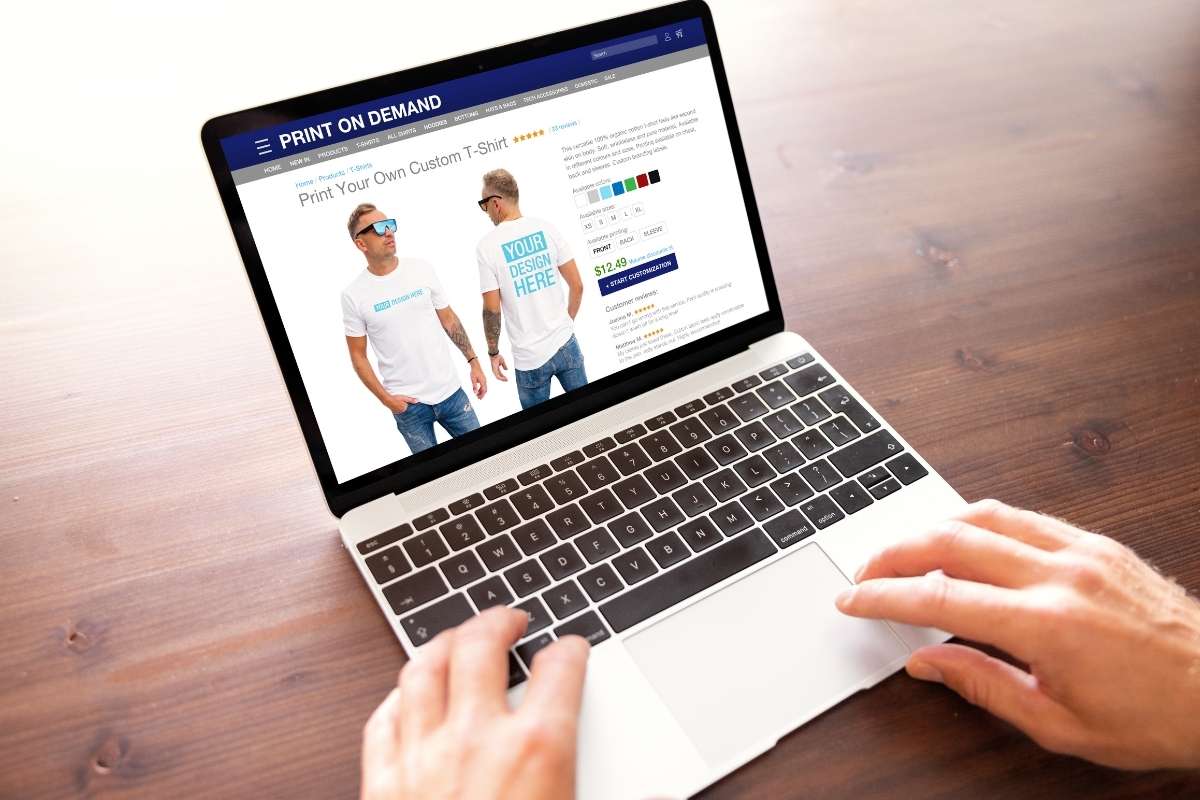
You can sell on:
- Shopify for a custom brand experience
- Etsy if you want access to built-in traffic
- Amazon Merch on Demand for global reach
Step 6: Optimize Your Listings
- Use SEO-friendly product titles (e.g., “Custom Vintage Band Tee – Soft Cotton Graphic Shirt”)
- Add detailed descriptions (mention fabric, fit, care, and print method)
- Use lifestyle and flat lay photos to enhance visual appeal
Step 7: Start Marketing
- Use Instagram, TikTok, and Pinterest for organic growth
- Run targeted Facebook or Google Ads
- Offer discounts for first orders or limited edition drops
Step 8: Fulfill Orders Automatically
Your POD platform will handle order processing, printing, packaging, and shipping—so you can focus on marketing and scaling.
Final Thoughts
If you’re serious about building a successful POD business, don’t overlook the foundation—your blank t-shirts. The right printing method and tee quality can make or break your brand’s first impression. By using U.S.-based POD platforms with fast shipping, top-tier blank selections, and printing flexibility, you’ll deliver products your customers love—and keep them coming back.

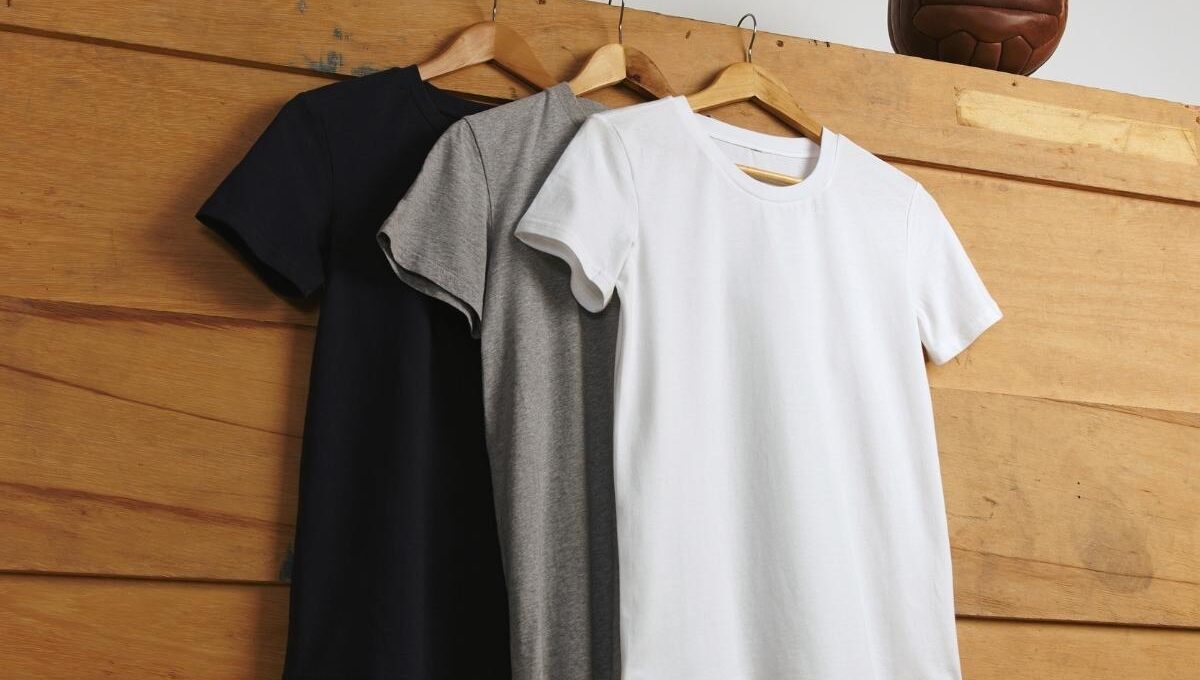
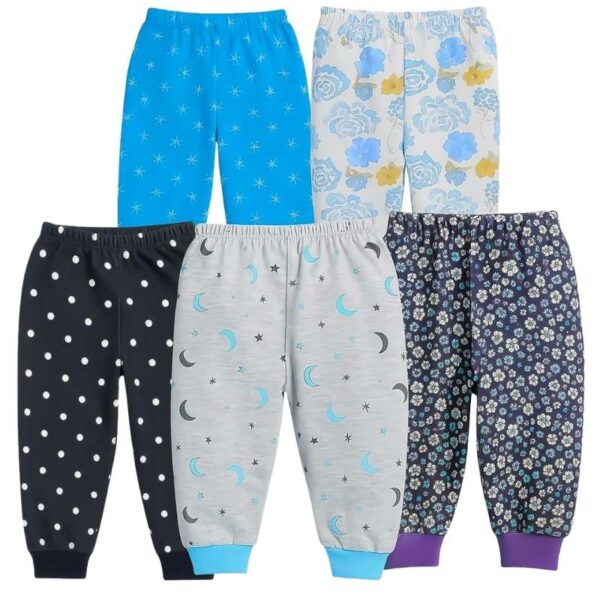
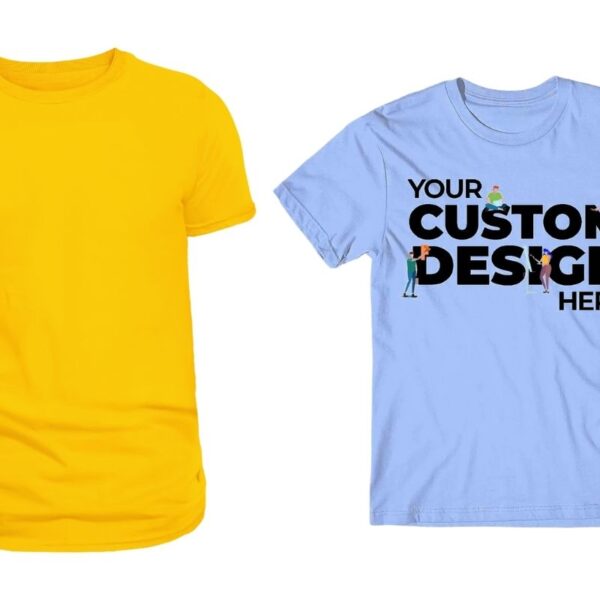
Sign up